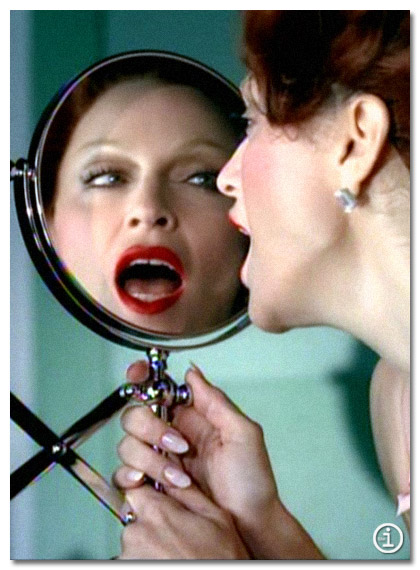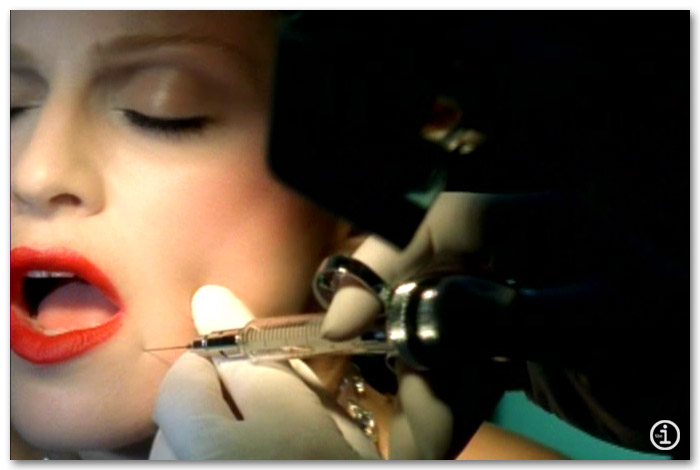| |
| |
Newflash: Madonna is aging! Every morning, our little Material
Girl wakes up another day older.
Consider: It’s already been seven years since Ray
of Light dawned, eleven years since Human
Nature debuted, fifteen years since Blond
Ambition struck, twenty-two long years since Holiday.
In only three years, Madonna will be eligible for entry
into the prestigious and (no offense, U.K.) real Rock and
Roll Hall of Fame.
|
|
 |
No one should
expect so prolific a person, so creative an artist, so scrutinized
an idol to look the way she did when it all began. By now,
given what she has accomplished, she should be a prune juice-sipping,
huddled mass of wrinkles in some luxury rest home, occasionally
surfacing to do a cabaret show or hock merchandise on the
Home Shopping Network.
But no! She’s as vibrant and ambitious as ever. Madonna’s
nearly forty-seven and looks great. When she’s “on,”
she’s certainly “on” - styled within an
inch of her life, outrageously fit, impeccably made-up.
That she looks and sounds fabulous so late into her enviable
career is despite - not because of - her immeasurable talent
and farsightedness.
And yet there has been an almost constant analysis of Madonna’s
beauty and whether it is waning.
Our celebrity culture has transcended the most overt product
of entertainment - that is, film, television, music, and
theater themselves - to infiltrate the most intimate aspects
of its promulgators’ lives.
Thus, we get paparazzi snapshots of Madonna biking through
London, leaving yoga class in Los Angeles, and (coming soon!)
picking her nose in Central Park.
Worse, there is the ongoing dialogue both in the press and
among pop culture enthusiasts about how old she looks. She,
like many in the public eye, is dogged with superficial
attacks whenever she lets her guard down, labeled “haggard,”
“tired,” or “ancient.” God forbid
the poor woman stay out a bit late one night and actually
display some under-eye baggage. (I mean, who among us has
not been there?) |
|
| |
This obsession creates a twofold problem: it feeds upon
itself in a vicious cycle and engenders stars playing along
(e.g., wearing cutesy message t-shirts for the press to
prey upon, selling pictures of private events, whoring out
their families to interviewers) blurring the lines of sheer
entertainment for the sake of entertainment and “real
life.” Fan and media interaction become crucial elements.
Madonna, once called the most photographed woman in the
world, does not escape this game and can perhaps be credited
with pushing celebrity-as-commodity to its economic apex.
Or is that nadir? |
|
| |
Over the years, Madonna has invited everyone to check her
out, warts and all, and has all but begged the media to
document her life for us all to watch. And we have.
The problem arises when we get so caught up in the put-down
of the external that Madonna, for all her open-mindedness,
becomes absolutely terrified of aging, or at least the physical
manifestation of aging.
Growing old is part of humanity and, to those whose livelihood
ostensibly relies on youth and beauty (which any true Madonna
fan would argue she is exempt from), humanity also means
fearing what is perceived as physical decline.
I, for one, happen to like my Madonna growing old gracefully.
Watching her evolve from the punky, gum-snapping brat in
the early eighties through the various stages of her life
has been interesting.
The recent Versace campaign, dutifully airbrushed of all
imperfections, does not follow the natural progression of
a woman who has again and again awed everyone with her artistic
gifts and has a strong sense of herself to accept and build
on her legacy. It instead reflects a woman nearing fifty
who is desperately clinging to the romanticized vision of
being young and, hence in her and projected audiences’
(and, crucially, customers’) minds, sexy.
|
|
| |
It will take a major overhaul of how consumers take in their
entertainment before the emphasis on beauty and age is turned
on its ear. As old as time, the system apparently works,
giving us so-called aspirational icons, people we should
look to for guidance on what the ideal is or should be.
It’s a system that has given us the improbably proportioned
Barbie dolls, eating disorders, and, of course, plastic
surgery. |
|
 |
| |
By her own admission, Madonna subsisted on popcorn and ice
cream sundaes in the early stages of her dance and music
careers. While never chubby by any means, the baby fat-adorned
twenty-five year old soon became a goddess of physical fitness
and corporeal dedication.
Her raving about Krispy Kreme doughnuts, even as recently
as her appearance on MTV’s “TRL” in 2000,
made her more of an authentic person, one who might think
twice about a macrobiotic diet (also soon abandoned in part).
Whispers of a nose job, anabolic steroids, facelifts, and
Botox confuse matters: “Wait, is she for real or not?”
It’s a secret. It’s all an illusion. It’s
marketing.
|
|
 |
However, by falling into the pervasive trap of critiquing
how “old” or “exhausted” our idol
looks, we’re practically handing her a knife by
which to carve up her face.
We already have enough Chers and Michael Jacksons in the
world. Let’s do our part to encourage respect of
Madonna as Madonna from start to finish, the way she was
biologically intended to look and morph throughout a storied
career. She’s earned those fine lines! I want to
be able to match up a picture of Madonna circa 1987 and
Madonna in 2012 and say, “Yeah, I can totally see
the evolution.”
It’s okay to share in the watercooler talk about
what she’s up to and what she was wearing and why
she tolerates a link to Britney Spears beyond Me
Against the Music, but putting Madge down for
occasionally looking, oh, just a few years younger than
she is rather than many years younger than she is fuels
the fire.
Plus, if she gets too much work done, she may be rendered
unrecognizable, leaving us to ask, “Who’s
That Girl?”
|
|
|
|
|


